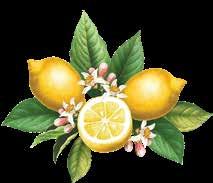
12 minute read
Pulp Non Fiction

When Life
gives you lemons
Today, when you walk into the produce section of a grocery store, there are dozens of types of citrus fruit from which to choose. It’s odd to think they all descended from four ancestors: the citron, the pomelo, the mandarin, and the papeda. Citrus first appeared in Asia, where the fruit was domesticated at least 3,300 years ago. In the beginning, however, the fruit was so acidic that it was considered inedible. Exactly when citrus transformed into fruit fit for human consumption is not easy to pinpoint. Let’s first look at these ancient fruits to get a better understanding of the history and evolution of today’s citrus.
CITRON is the oldest known type of citrus. The name “citrus” now used to describe this entire group of fruits is derived from the word “citron.” Citron seeds dating back more than 6,000 years ago were found in Mesopotamian ruins. Descriptions recorded by botanists who accompanied Alexander the Great on his campaigns tell us that citron was being cultivated in Persia and the Middle East at that time. It was adopted into Jewish religious ritual and became established throughout the Mediterranean basin after it was introduced around 325 B.C. By 200 B.C. it had also started to spread to southern Italy. Murals in Pompeii depict citron, and ancient documents demonstrate that citron was a common commercial food available in Rome in 301 A.D. Cultivation of citron was happening throughout Sicily and the Venetian ruled Greek islands, including Corfu by the fourth century A.D. The island was even supplying citron to the Jews of France and Germany for their annual Feast of the Tabernacles ceremony. Several varieties of this first fruit are grown today.
The POMELO (or pummelo) comes from southeast Asia, where it grows wild. It may have been an aboriginal introduction to Fiji and was naturalized there. It is commonly cultivated in the islands of French Polynesia. In the last century B.C. the fruit was introduced to southern China. It appeared in the Caribbean and South America in the late 17th century when an English sea captain named Shaddock stopped at Barbados in the West Indies, on his way home from the Pacific. Thinking the climate was appropriate for growth, he left pomelo seeds on the island where they flourished and produced fruit. The new fruit was named after him and, in some areas, it is still known as shaddock. It spread from there to Jamaica and Puerto Rico. Pomelo never became fully established in the west, growing mainly as a curiosity item in private gardens in Florida, the Caribbean Islands and Mexico. Hybrids of this fruit and a local variety of sweet orange were found around 1720 on the island and later became known as grapefruit. First attempts at commercial production of the pomelo outside Asia were made at the beginning of the 1900s in California and Florida.
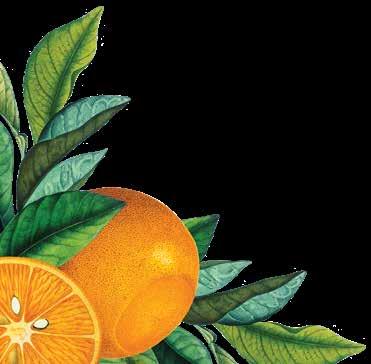
Pulp non Fiction
POMONA
ABOVE: Pomona, the Roman mythologcial goddess of fruitful abundance, is said to have been a wood nymph, reigning over fruit trees, gardens, and orchards with a pruning knife. Her name comes from the Latin word pomum, meaning “fruit,” specifically orchard fruit.

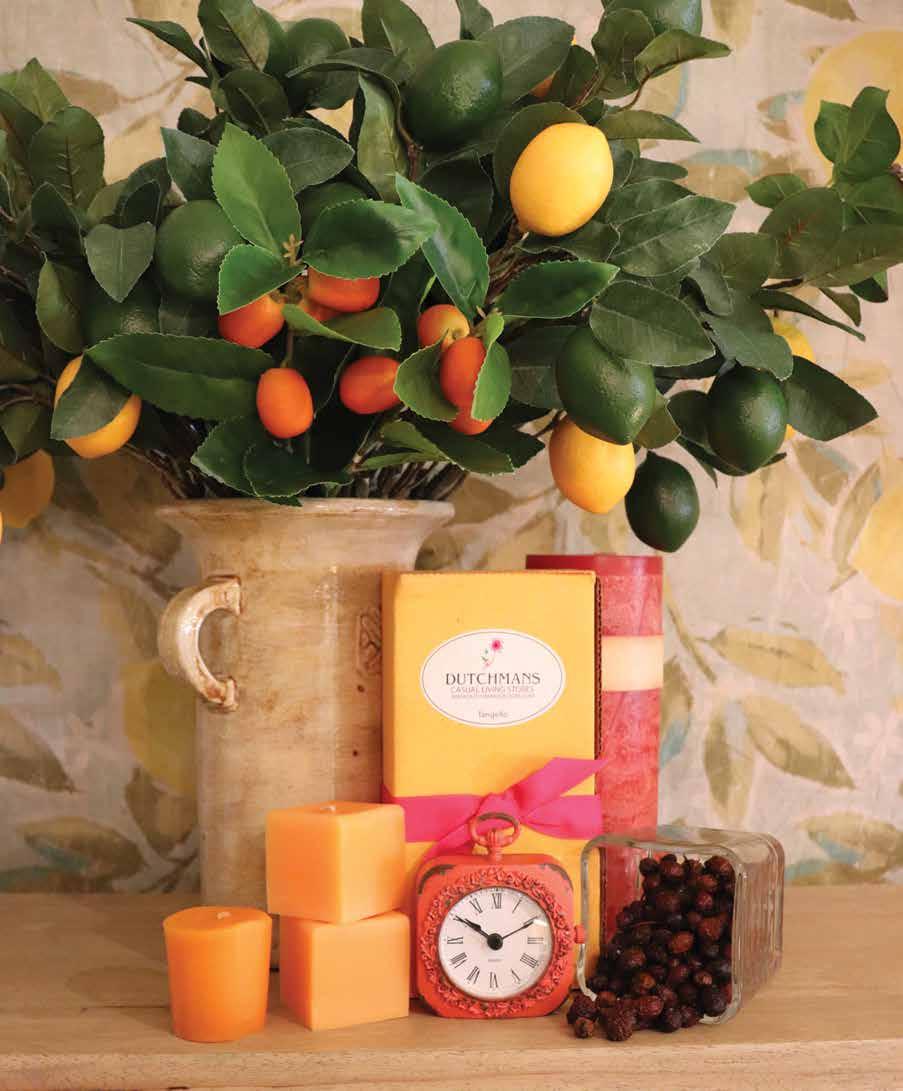
When Life

gives you lemons
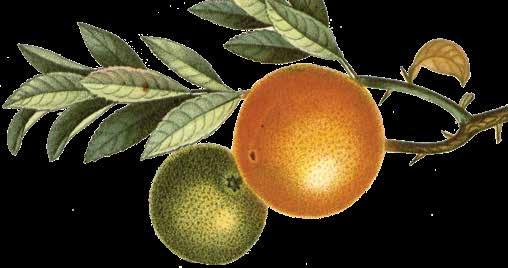
PAPEDAS are a group of acid wild citrus types growing in the monsoon region and parts of Japan and China and are really a subgenus of the citrus species. An inedible fruit, papedas belong to the oldest and most primitive known citrus types and are significant for the contribution of their genes to many well-known citrus fruits, including various kinds of limes.
MANDARINS have been grown in China and Japan since the 16th century, but they were the last of the important citrus fruits to make it to Europe, arriving as late as the early 19th century. In 1805, two varieties of the Mandarin oranges were brought into England from Canton. From England, they were introduced into the Mediterranean region. By 1850, the fruit was wellestablished in Italy. Around that same time, the Italian Consul
OPPOSITE PAGE: Citrus was coveted by the elite classes for its intense fragrance and medicinal properties. Citrus oils are commonly used in candles, potpourri, and household cleaners. This Tangelo blend is a signature scent available at Dutchmans Designs, located at 505 Beachview Drive. Their Sweet Lime products are also popular. imported a mandarin from China and planted it at the Consulate in New Orleans. Of course, like all other citrus in the United States, it made its way to Florida and then California where temperatures are better for growth. After the Owari Satsuma arrived from Japan in 1878, nearly a million trees were planted in the Gulf States between 1908 and 1911. Another variety, the King Mandarin, was sent from Saigon to California in 1882. In the late 1800s, two fruits of the Ponkan variety were sent from China to Florida, and the distribution of those seedlings led to commercial propagation.
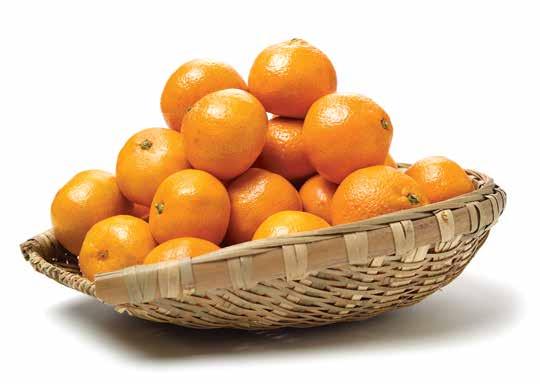
Mandarin with its hybrids and relatives form the largest group of citrus fruit. The number of commercially important mandarin varieties is almost equivalent to the number of all other citrus types combined. Classification of mandarins is complicated, with some types, including satsumas, forming species of their own, but many other mandarin types and their hybrids are still lumped together in the mandarin class, including clementines, tangerines, tangelos, and tangors. There are more than 300 commercially grown varieties of mandarin in the world and, due to the appeal of their easy-peeling, seedless, flavorful fruit, they are also the fastest growing sector of the citrus industry. The mandarin also played a significant role in the evolution of sweet citrus fruit, as a base fruit for many hybrids, like the sweet orange.
Now that we’ve introduced their ancestors, we can turn to the citrus fruit we know more commonly today. The first lemons (a hybrid of citron and sour orange) appeared in Rome around the first century A.D. from early remains found in the Roman Forum. Sour oranges, limes and grapefruit arrived in the Mediterranean during the tenth century with the Muslim expansion. It wasn’t until the late 1400s that the sweet orange (a hybrid between pomelo and mandarin) was introduced to Europe from the Far East, through trade routes established by Italian and Portuguese merchants. Portuguese explorer Vasco de Gamma recorded in 1498 that there was an abundance of orange trees in India bearing sweet-tasting fruit. The new sweet “Portugal orange” caused a dramatic surge in citrus planting in Europe and changed the dynamics of citrus fruit importance in the world. The last to arrive on the European and
American citrus scene were mandarins and grapefruit.
When Life

gives you lemons
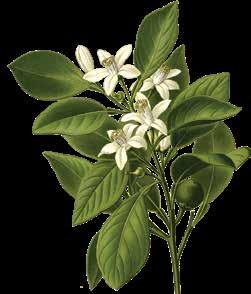
ABOVE:
Incorporating a lemon theme into your kitchen decor or on your table can brighten up the room with its sunny yellow colors. These serving pieces are just some of the lemon tableware and accessories available at St. Simons Drug Co., located at 209 Longview Plaza. The origin of the LEMON is unknown, though it is believed to have come from somewhere in India. There are early reports of it in southern Italy and in the third century A.D. and in Iraq and Egypt sometime around 700 A.D. Facts do firmly establish that it was grown in Sicily around 1000 A.D. Arab conquerors took the lemon with them around the Mediterranean to Spain where it has been flourishing since 1150 A.D. When Marco Polo arrived in China in 1297, lemons were being grown there. In Europe, the island of Sicily and other parts of southern Italy had been importing lemons for several centuries. In 1493, Christopher Columbus introduced citrus to Haiti, bringing seeds of both sour and sweet oranges, citron, lemon, lime, and pomelo to be planted. The lemon spread to other islands and the continent.
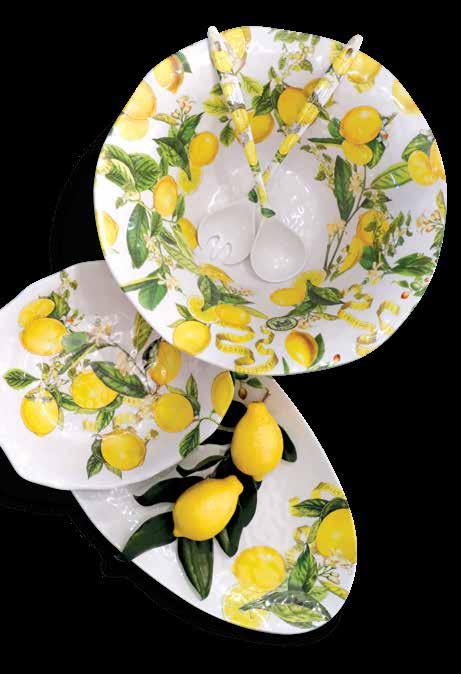
ORANGES originated as the sour orange, which is thought to have come from India and its neighbors in China and Burma, reaching the Near East at the beginning of the Christian era. Arabs had conquered southern Spain by 711 A.D., and under orders of the Caliphs of Cordoba, sour orange trees were planted in prominent public spaces in the most important towns. This strain of sour orange that was brought to Spain by Arabs is what we now call the Seville orange. Another strain of sour orange, the Bittersweet orange, was brought back by crusaders returning from the Holy Land in the twelfth and thirteenth centuries. It was the Bittersweet orange that made its way to northern Mediterranean countries, then to Versailles and eventually to America. In the Middle Ages, in central and southern Europe, citron and sour orange were the only known citrus fruit. Up until the end of the eighteenth century, any written reference to orange refers to the sour orange. It was used as a medicinal plant and a condiment to flavor foods. The flowers were also valued for their fragrance. The crusades created interest and demand for new and exotic products, with Genoa and Venice maintaining trading routes from Italy through Palestine and Arabia to India for several centuries. Increasing trade with India and the Far East and the voyages of the explorers in the late 15th century brought many delicious discoveries, including the sweet orange.
Literary sources establish that by 1525, the sweet orange was cultivated in Sicily, Calabria and southern Spain. Inferior varieties compared to what we know today, they were used mainly as condiments. After the Portuguese started importing new varieties of sweet orange directly from China in the first half of the seventeenth century, its popularity slowly spread to other parts of southern Europe. The first modern type of sweet orange tree was imported to Portugal in 1635. By fifteen years later, it was wellestablished in France and Italy. Since the fruit was sweet and could be eaten fresh, unlike the other citrus known at the time, it displaced the use of the sour orange. Special greenhouses (orangeries) built to protect the citrus from frost became common.
MARCH 2021 27

Luxury Fishing, Scuba Diving, and Private Cruises
WELCOME ABOARD THE EDMOND DANTES- a 54’ luxury yacht ported in St. Simons Island. Legacy Charters offers the only luxury and fully customizable ocean adventures in the Golden Isles. We are booking fishing, scuba diving, and private cruises with your own private host and first mate. The yacht is fully air conditioned, multi head, and full galley luxury yacht with all amenities. Legacy Charters will customize your ocean adventure for fishing, diving, short and long cruises, and even host your private event.
BOOK NOW!
912.357.3550 legacychartersssi.com
The Proven Path to Wellness
We get it. Wellness can be confusing. It’s difficult to sort through trending diets, fitness fads, and body sculpting options, and going to a traditional gym can be intimidating.
Golden Isles Wellness offers a comprehensive approach for you to achieve your total wellness goals. Enjoy a fitness suite where our multi-certified Personal Trainer and Nutrition Consultant Tanya offers private one-on-one sessions. We also offer massage and the latest technology in cosmetic aesthetics. Our Licensed Nurse Practitioner Jourdain and Registered Nurse Brittney can assist with primary and urgent care needs for all ages. Let us help you be your best.

Affiliated with Seaworthy Health
COMPLIMENTARY INITIAL TOTAL WELLNESS CONSULT
406 Union St., SSI | 912.357.3660 Monday – Friday 10 a.m. – 6 p.m. Saturday 10 a.m. – 4 p.m. goldenisleswellness.com instagram / facebook @GoldenIslesWellness

When Life
gives you lemons
Early Spanish explorers (probably Ponce de Leon) planted the first orange trees near St. Augustine, Florida in the 1500s, and historical records show that these citrus trees were well established by 1565 both there and in coastal South Carolina. In the 1700s, oranges were noted as one of the many types of fruit trees grown by Spanish missions, according to horticultural documents. In the late 1800s, after the Civil War, commercial production of oranges in the United States began in earnest thanks to the development of the railroad which allowed citrus growers to ship their products across the country. Large-scale commercial cultivation of lemons began in Florida and California in the early days of the 19th century as well.
LIMES are closely related to lemons, and are native to Southeast Asia, likely originating in Indonesia or Malaysia. They too made their way to the eastern Mediterranean with the Arabs, and to the western Mediterranean, with returning Crusaders, and eventually to the West Indies via Columbus. The first mention of limes in European history is attributed to Sir Thomas Herbert’s reference to finding “oranges, lemons, and limes” off Mozambique in the mid-1600s. These limes, commonly used in most of the world, are what we call Key Limes. The large green seedless limes you find at the grocery store are Persian or Tahiti Limes, a thicker-skinned, more disease resistant hybrid developed in the early twentieth century.
The origin of GRAPEFRUIT is particularly muddled. It is believed to have first appeared on Barbados, but it’s uncertain whether it was a horticultural accident or a deliberate hybridization (probably between pomelo and orange) which gave birth to the grapefruit. The fruit, which was the size of an orange then, may have also been called the “forbidden fruit” and “shaddock,” but later was given the name grapefruit, possibly because the fruit grows in clusters like grapes or possibly because their taste was described to be like unripe grapes. Frenchman Odet Philippe is generally credited with bringing the grapefruit to Florida in the 1820s. Until the latter part of the century, most farmers dismissed grapefruit as inedible. The first grapefruit nursery was established in Florida around 1870. The first shipment of grapefruit to New York and Philadelphia in 1885 generated the needed interest to help launch the commercial grapefruit industry. By 1910, grapefruit was being grown in Texas, Arizona, and California. Sweeter pink grapefruit, Ruby Reds, and other varieties were developed from there, and by the 1940s grapefruit was a household favorite.
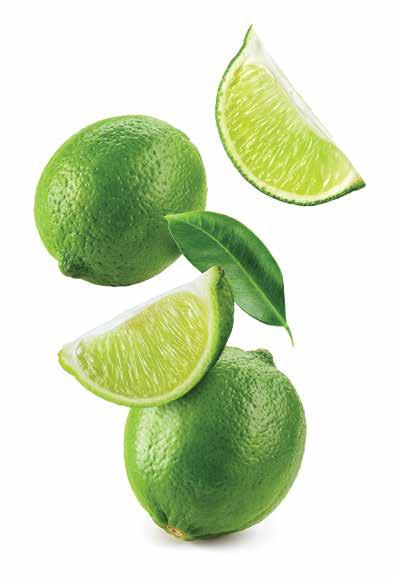
YOUR OWN ISLAND OASIS
6 Bedrooms: SLEEPS 16 HEATED Private Pool Easy Walk to the Beach,

LIGHTHOUSE AND THE VILLAGE
BIG ENOUGH FOR YOUR










